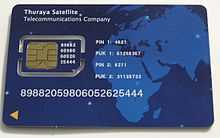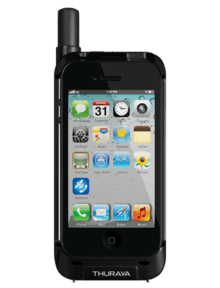Thuraya
|
| |
| Industry | Satellite communication |
|---|---|
| Founded | 1997 |
| Headquarters | United Arab Emirates |
| Key people | CEO Samer Halawi |
| Website | www.thuraya.com |
Thuraya (Arabic: الثريا, pronounced [aθːuˈrajːa]), from the Arabic name "Thurayya" meaning the Pleiades,[1] is an international mobile satellite services provider based in the United Arab Emirates. The company claims to operate in more than 140 countries across Europe, the Middle East, North, Central and East Africa, Asia and Australia.[2] With more than 350 roaming partners worldwide, Thuraya is the only mobile satellite operator that offers GSM roaming services over mobile networks.
Use of Thuraya Satphones was banned in India in 2010,[3] after the company failed to convince the Indian government that its services could not be abused by terrorists targeting India.[4]
Established in 1997, Thuraya’s satellites enable two-thirds of the globe’s population to communicate in areas unserved by terrestrial networks. The organization provides data and voice satellite communications solutions in remote locations for the energy, media, government, NGO and maritime sectors.
They have sold in excess of 650,000 satellite handheld phones since launching in 2001.[5] Thuraya offers the only dual mode satellite phone, the Thuraya XT-DUAL, a handset that features both GSM and satellite capabilities. In addition, Thuraya provides the Thuraya IP data modem, a secure and rapidly deployable satellite broadband solution offering connection speeds up to 444 kbit/s standard IP.
The company is headquartered in the United Arab Emirates and distributes its products and service through authorized service partners worldwide. Its shareholders consist of investment companies, Middle Eastern and North African telcos in which Etisalat is a major one.
Services

- Voice communications with satellite phones (Thuraya XT-DUAL, Thuraya XT, Thuraya SO-2510 (discontinued), Thuraya SG-2520 (discontinued), Hughes 7100 (discontinued), 7101 (discontinued) and Ascom 21 (discontinued)) or fixed terminals
- Short message service
- 9.6 kbit/s of data & fax service
- 60 kbit/s downlink and 15 kbit/s uplink "GMPRS" mobile data service on Thuraya satellite phones
- 144 kbit/s high-speed data transfer via a notebook-sized terminal (ThurayaDSL)
- GPS is supported by all handsets
- A number of value-added services, such as news, call back, call waiting, missed calls, voicemail, WAP, etc.
- A one-way 'high power alert' capability that notifies users of an incoming call, when the signal path to the satellite is obstructed (e.g. inside a building)
- Marine Services: a combination of a special (fixed) base station and subscription offering voice, fax, data and always on internet-access. Also an emergency service which, when activated, sends multiple SMS messages containing alarm-status and actual position to pre-defined destinations
Subscriber equipment
Thuraya offers a range of products sold under their own brandname. Besides these products some 3rd party developers offer complete systems and accessories for their products.[6]
Handsets

Most Thuraya handsets[7] (except Thuraya SO-2510 and Thuraya XT) have a dual-mode feature that allows them to operate in the Thuraya satellite network and GSM terrestrial mobile networks. Thuraya has concluded roaming agreements with over 300 wireless (cellular) operators around the world, providing its customers the ability of using their Thuraya phones with standard GSM SIM cards. Thuraya customers in the region can now make and receive calls, and also send and receive text messages (SMS).

In 2013, the company launched the Thuraya SatSleeve. The world’s first satellite adaptor for the iPhone, the SatSleeve provides users with easy and affordable access to mobile communication services delivered over Thuraya’s powerful satellite network.
Roaming for outgoing calls is only available for postpaid subscribers. For pre-pay (scratchcard) users of Thuraya roaming is only available for receiving incoming calls.
First Generation
The Thuraya service was initially provided on Hughes 7100, 7101 and Ascom 21 handsets. These have been discontinued.
Second generation
The satellite-only Thuraya SO-2510 was released in November 2006. It has a colour screen and is claimed to be the smallest and lightest satellite phone in the world and uses the VxWorks operating system. The Thuraya SG-2520 was released in early 2007, this is a dual-mode handset that also connects to GSM/GPRS services and is based on Windows CE and made by Apsat in South Korea.[8] The device is slightly bigger than the Thuraya SO-2510 but it also has a camera, GPS and support for SD Cards. The operating system is a rather customized version of Windows CE and is not at all like Windows Mobile. It has support for running Java ME applications only. These have been discontinued.
Third generation
The satellite-only Thuraya XT was released in August 2009. It has a colour screen and is claimed to be the toughest satellite phone in the world at the time of the launch. The new IP54-rated rugged model is dustproof, shockproof and splash-waterproof and offers GSM-like options like phone-calls, SMS / text services and internet access.[9]
The[10] Thuraya XT-DUAL is a dual-mode satellite phone that works in satellite and GSM modes. This was released in March 2012.
Docking station
For the Thuraya satellite phones there are different docking-stations available. These docking stations change a handset into a fixed terminal for indoor use or vehicle use, using external antennas for communication and GPS.
Data Terminals
For data-only, an A5-sized terminal is available, providing an always on TCP/IP connection to internet via an Ethernet interface with a PC at speeds up to 444 kbit/s. Thuraya offers the Thuraya IP and the Thuraya DSL. The IP offers an always on internet access and the DSL offers general packet data GPRS services.
In 2013, Thuraya released the IP+. Weighing 1.4 kilograms, it is smaller than a regular laptop and can be rapidly deployed to support high-bandwidth applications at speeds of up to 444kbit/s on standard IP and 384kbit/s on streaming IP with a built-in antenna. The Thuraya IP+ can be configured to provide asymmetric streaming capabilities which enable users to control their upload and download speeds based on usage requirements. Its enhanced capabilities include live high quality video broadcasting, web browsing, email, social media communications, data transfer and VoIP applications, as well as access to corporate networks from remote locations.
An analog telephony adapter for the Thuraya network also exists.
Maritime
Thuraya has developed high-speed broadband terminals and mobile satellite phones provide merchant and fishing vessels and their crew with voice calls, fax, SMS and Internet services. The equipment also allows vessels to download navigation and weather data, satellite imagery, and emergency calls to help them stay in track and monitor sea-faring circumstances.
Thuraya MarineComms products include the Seagull 5000i with Fax Connect, the SF2500 and Thuraya Maritime Broadband.
Other devices
Besides the above satellite phones and modules some special purpose fixed devices are developed. A payphone using chip-cards and Public Calling Office phones to offer public telephone services in areas without other communication services (e.g. disaster areas).
Repeaters similar to the cellular repeaters used on terrestrial networks are available for the Thuraya network. These units also amplify the satellite and the GPS signal, allowing satellite phones to work indoors. The smallest consumerised repeater will only support one handset at a time while the larger and more expensive repeater supports up to 10 simultaneously.
Technical details of the network
Virtual country code
Thuraya's country calling code is +882 16, which is part of the ITU-T International Networks numbering group. Thuraya is not part of the +881 country calling code numbering group as this is allocated by ITU-T for networks in the Global Mobile Satellite System, of which Thuraya is not a part, being a regional rather than a global system.
Air interface
Transceivers communicate directly with the satellites using an antenna of roughly the same length as the handset and have a maximum output power of 2 Watts. QPSK modulation is used for the air interface. Thuraya SIM cards will work in regular GSM telephones and ordinary GSM SIM cards can be used on the satellite network as long as the GSM provider has a roaming agreement with Thuraya. As with all geosynchronous voice services a noticeable lag is present while making a call.
Due to the relatively high gain of the antennas contained within handsets, it is necessary to roughly aim the antenna at the satellite. As the handsets contain a GPS receiver it is possible to program the ground position of the satellites as waypoints to assist with aiming.
Use of GPS
Every Thuraya phone and standalone transceiver unit is fitted with a GPS receiver and transmits its location to the Thuraya gateway periodically.[11][12] The built-in GPS capability can be used for waypoint navigation.
Satellites

Thuraya operates two communications satellites built by Boeing
- Thuraya 1
The first satellite, named Thuraya 1, had deficient solar panels and could not operate properly, this satellite was positioned above Korea for testing purposes. It was launched on 2000-10-21 by SeaLaunch on a Zenit 3SL rocket.[13] At launch it weighed 5250 kg.[14] The satellite was used for testing and backup until May 2007, when it was moved to junk orbit and declared at its end of life.[15]
- Thuraya 2
Thuraya 2 was launched by SeaLaunch on 2003-06-10.[16] It is located in geosynchronous orbit at 44 deg-E longitude, inclined at 6.3 degrees.[17] The satellite can handle 13,750 simultaneous voice calls. This satellite currently serves most of Europe, the Middle East, Africa and parts of Asia. The craft had a weight of 3200 kg and an expected life of 12 years. The two solar-panel wings, each containing 5 panels, generate 11 KW electric power (at end of life). The craft has two antenna systems: a round C-band antenna, 1,27 meter in diameter and a 12 x 16 meter AstroMesh reflector, 128 element L-band antenna, supplied by Astro Aerospace in Carpenteria, CA. These antennas support up to 351 separate spot beams, each configurable to concentrate power where usage needs it.[18]
- Thuraya 3
The third satellite was planned for launch by SeaLaunch in Q1 2007, and the start of Far East and Australia service was planned for 2007-10-15. The failure in January 2007 of the NSS-8 rocket led to a substantial delay in the launch of Thuraya-3, which was rescheduled for 2007-11-14, but the launch was postponed several times due to sea conditions.[19] The launch vessels set out from port again on 2008-01-02, and launch occurred successfully at 11:49 GMT on 2008-01-15.[20][21] The Thuraya 3 satellite is technically the same as Thuraya 2, but located in geosynchronous orbit at 98.5 deg-E longitude, inclined at 6.2 degrees.
See also
- Broadband Global Area Network
- GEO-Mobile Radio Interface
- Globalstar
- Inmarsat
- Iridium
- O3b
- SkyTerra
- SkyWave Mobile Communications
References
- ↑ "Arabic stars: Stellarium Wiki".
- ↑ "Thuraya coverage map". Thuraya.
- ↑ Consulate General of India retrieved 15 Jan 2013.
- ↑ India cracks down on Thuraya Satphones published 03 May 2010.
- ↑ http://www.satelliteprome.com/vertical-markets/thuraya-launches-satellite-gsm-phone-xt-dual/
- ↑ Updated equipment information from the Thuraya webpage. Visited on 24 July 2012
- ↑ Company website describing all visited 24 July 2012
- ↑ Asia Pacific Satellite Industry Co., Ltd
- ↑ Thuraya XT details on company website, visited 24 July 2012
- ↑ Thuraya, XT-DUAL. "Thuraya XT-DUAL". Thuraya Telecommunications Company. Retrieved 24 July 2012.
- ↑ "XSAT USA plays role in recent K2 mountain rescue". Xsatusa.com. Retrieved 2012-01-10.
- ↑ "Electronic Weapons". Strategypage.com. 2003-04-24. Retrieved 2012-01-10.
- ↑ "Thuraya 1". NSSDC.
- ↑ "Thuraya-1 Complete System for Mobile Communications". Boeing.
- ↑ TBS info on Thuraya 1, visited on July 12, 2008
- ↑ "Thuraya 2". NSSDC.
- ↑ "Sea Launch Past Launches Thuraya-2". Boeing.
- ↑ Thuraya 2 and 3 info on Boeing website
- ↑ "Current Mission: Thuraya-3". Sea Launch.
- ↑ "Sea Launch Continues Thuraya-3 Mission". SeaLaunch.
- ↑ "Sea Launch Delivers Thuraya-3 Satellite to Orbit". Sea Launch.